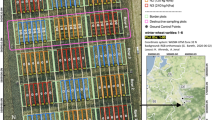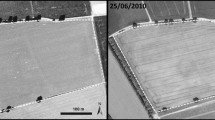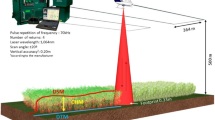Abstract
This study evaluated the capabilities of a LiDAR-based system to characterize poplar trees for biomass production. The precision of the system was assessed by analyzing the relationship between the distance records and biophysical parameters. The terrestrial laser scanner (TLS) system consisted of a 2D time-of-flight LiDAR sensor, a gimbal to dynamically stabilize the sensor and a RTK-GPS to georeference its location and, subsequently, the sensor data. The sensor and its stabilizer were fixed facing downwards, on a metal frame designed for this purpose. Then, it was mounted on an all-terrain vehicle to perform 2D scans in planes perpendicular to the travel direction. Distances between the sensor and the surrounding objects had a high spatial resolution, providing high density 3D point clouds. Results on the reliability of the LiDAR system to estimate plant height showed a significant relationship between the sensor readings and actual poplar height and biomass data. In addition, tree biomass and tree volume were properly estimated in the point cloud. Regression analysis showed significant estimates of 0.79 and 0.89 for biomass and volume, respectively. These results reveal the potential of the LiDAR sensor to estimate both, plant height and plant biomass. This sensor’s capability, added to its relative low cost, fast reaction, and the high number of readings per second consolidate the ideal system for estimating the productivity of biomass in energy crops.
Zusammenfassung
In dieser Studie wurden die Fähigkeiten eines LiDAR-basierten Systems zur Charakterisierung der Biomasseproduktion von Pappelbäumen untersucht. Die Genauigkeit des Systems wurde durch Analyse der Beziehung zwischen dem Abstand und den biophysikalischen Parametern bewertet. Das terrestrische Laserscanner (TLS)-System bestand aus einem 2D-Flugzeit-LiDAR-Sensor, einer kardanischen Aufhängung für die dynamische Stabilisierung des Sensors und einem RTK-GPS für die Georeferenzierung innerhalb des Feldes und der resultierenden Sensordaten. Der Sensor und sein Stabilisator wurden auf einem für diesen Zweck ausgelegten Metallrahmen nach unten ausgerichtet und anschließend auf einem Geländefahrzeug montiert, sodass 2D-Scans in Ebenen senkrecht zur Fahrrichtung durchgeführt werden konnten. Die Entfernungen zwischen Sensor und den umliegenden Objekten hatte eine hohe räumliche Auflösung und lieferte so eine höhere Dichte der 3D-Punktwolken. Die Ergebnisse der Funktionsfähigkeit des LiDAR-Systems zur Bestimmung der Pflanzenhöhe zeigten eine starke Beziehung zwischen den Sensormesswerten und der tatsächlichen Höhe der Pappeln und der Biomassedaten. Darüber hinaus wurden die Baum-Biomasse und das Baumvolumen in der Punktwolke richtig geschätzt. Die Regressionsanalyse zeigte signifikante Schätzungen von 0,79 bzw. 0,89 für Biomasse und Volumen. Diese Ergebnisse zeigen deutlich das Potenzial des LiDAR-Sensors, um sowohl Pflanzenhöhe als auch pflanzliche Biomasse abzuschätzen. Das Leistungsvermögen dieses Sensors – zusätzlich zu relativ geringen Kosten, schneller Reaktion und hoher Zahl an Messwerten pro Sekunde – konsolidiert das ideale System, um die Produktivität von Biomasse in Energiepflanzen zu bewerten





Similar content being viewed by others
References
Andújar D, Escolà A, Rosell-Polo JR, Fernández-Quintanilla C, Dorado J (2013) Potential of a terrestrial LiDAR-based system to characterize weed vegetation in maize crops. Comput Electron Agric 92:11–15
Andújar D, Ribeiro A, Fernández-Quintanilla C, Dorado J (2011) Accuracy and feasibility of optoelectronic sensors for weed mapping in wide row crops. Sensors (Basel) 11:2304–2318
Börjesson P (1999) Enviromental effects of energy crop cultivation in Sweden – part I: identification and quantification. Biomass Bioenergy 16:137–154
Cescatti A (2007) Indirect estimates of canopy gap fraction based on the linear conversion of hemispherical photographs – methodology and comparison with standard thresholding techniques. Agric For Meteorol 143:1–12
Crimmins MA, Crimmins TM (2008) Monitoring plant phenology using digital repeat photography. Environ Manage 41:949–958
Dassot M, Baracci A, Colin A, Fournier M, Constant T (2010) Tree architecture and biomass assessment from terrestrial LiDAR measurements: a case study for some Beech trees (Fagus sylvatica). In: Proceed Silvilaser, Silvilaser, Freiburg pp 206–215
Diago MP, Correa C, Millán B, Barreiro P, Valero C, Tardaguila J (2012) Grapevine yield and leaf area estimation using supervised classification methodology on RGB images taken under field conditions. Sensors (Basel) 12:16988–17006
Gil E, Llorens J, Llop J, Fàbregas M (2013) Use of a terrestrial lidar sensor for drift detection in vineyard spraying. Sensors (Basel) 13:516–534
Henning J, Radtke P (2006) Detailed stem measurements of standing trees from ground-based scanning lidar. For Sci 52(1):67–80
Hunt ER, Cavigelli M, Daughtry CST, McMurtrey JE, Walthall CL (2005) Evaluation of digital photography from model aircraft for remote sensing of crop biomass and nitrogen status. Precis Agric 6:359–378
Keightley K, Bawden G (2010) 3D volumetric modeling of grapevine biomass using tripod LiDAR. Comput Electron Agric 74:305–312
Llorens J, Gil E, Llop J, Escola A (2011) Ultrasonic and LiDAR sensors for electronic canopy characterization in vineyards: Advances to improve pesticide application methods. Sensors (Basel) 11:2177–2194
Mirtich B (1996) Fast and accurate computation of polyhedral mass properties. J Graph Tools 1(2):1–15
Moorthy I, Miller JR, Berni JAJ, Zarco-Tejada P, Hu B, Chen J (2011) Field characterization of olive (Olea europea L.) tree crown architecture using terrestrial laser scanning data. Agric For Meteorol 151:204–214
Palacín J, Salse JA, Sanz R, Ribes-Dasi A, Masip J, Arnó J, Llorens J, Vallés JM, Escolà A, Massana P, Camp F, Solanelles F, Rosell JR (2006) Real-Time tree foliage estimation using a ground laser scanner. instrumentation and measurement. IEEE Trans 56:1377–1383
Pérez-Cruzado C, Sanchez-Ron D, Rodríguez-Soalleiro R, Hernández MJ, Sánchez-Martín MM, Cañellas I, Sixto H (2014) Biomass production assessment from Populus spp. short-rotation irrigated crops in Spain. GCB Bioenergy 6:312–326
Richardson JJ, Moskal LM, Kim SH (2009) Modeling approaches to estimate effective leaf area index from aerial discrete-return LiDAR. Agric For Meteorol 149:1152–1160
Rosell JR, Sanz R (2012) A review of methods and applications of the geometric characterization of tree crops in agricultural activities. Comput Electron Agric 81:124–141
Rosell JR, Llorens J, Sanz R, Arno J, Ribes-Dasi M, Masip J, Escolà A, Camp F, Solanelles F, Gràcia F, Gracia F, Gil E, Val L, Plans S, Palacin J (2009a) Obtaining the three-dimensional structure of tree orchards from remote 2D terrestrial LIDAR scanning. Agric For Meteorol 149:1505–1515
Rosell JR, Sanz R, Llorens J, Arno J, Escolà A, Ribes-Dasi M, Masip J, Camp F, Gràcia F, Solanelles F, Palleja T, Val L, Planas S, Palacin J (2009b) A tractor-mounted scanning LIDAR for the non-destructive measurement of vegetative volume and surface area of tree-row plantations: A comparison with conventional destructive measurements. Biosyst Eng 102:128–134
Saeys W, Lenaerts B, Craessaerts G, De Baerdemaeker J (2009) Estimation of the crop density of small grains using LiDAR sensors. Biosyst Eng 102:22–30
Tremblay N, Wang Z, Ma BL, Belec C, Philippe P (2009) A comparison of crop data measured by two commercial sensors for variable-rate nitrogen application. Precis Agric 10:145–161
Walklate P, Cross J, Richardson G, Baker D (2006) Optimising the adjustment of label-recommended dose rate for orchard spraying. Crop Prot 25:1080–1086
Wang Q, Nuske S, Bergerman M, Singh S (2013) Automated crop yield estimation for apple orchards. Exp Robot 88:745–758
Weis M, Gutjahr C, Rueda Ayala V, Gerhards R, Ritter C, Schölderle F (2008) Precision farming for weed management: techniques. Gesunde Pflanz 60:171–181
Yamamoto K, Guo W, Yoshioka Y, Ninomiya S (2014) On plant detection of intact tomato fruits using image analysis and machine learning methods. Sensors (Basel) 14:12191–12206
Zaman Q, Schumann A, Percival D, Read S, Esau T, Farooque A (2011) Development of prototype automated variable rate sprayer for real-time spot-application of agrochemicals in wild blueberry cropping systems. Comput Electron Agric 76:175–182
Acknowledgements
This research was funded by the CICyT (Commision Interministerial de Ciencia y Tecnología, Spain), under Agreement No. AGL2011-25243 and AGL2014-52465-C4.
Author information
Authors and Affiliations
Corresponding author
Rights and permissions
About this article
Cite this article
Andújar, D., Escolà, A., Rosell-Polo, J.R. et al. A LiDAR-Based System to Assess Poplar Biomass. Gesunde Pflanzen 68, 155–162 (2016). https://doi.org/10.1007/s10343-016-0369-1
Received:
Accepted:
Published:
Issue Date:
DOI: https://doi.org/10.1007/s10343-016-0369-1




